When it comes to measuring vacuum, there is a specific unit that is commonly used. Vacuum pressure is typically measured in units of pressure such as pascals (Pa), torr, or millibar (mbar). These units represent the force exerted by the absence of air or gas particles in a given space.
The Pascal (Pa) is the International System of Units (SI) unit for pressure and can be used to measure vacuum. One Pascal is equal to one newton per square meter. Another commonly used unit for measuring vacuum is the torr, which represents the pressure exerted by a column of mercury 1 millimeter high at 0 degrees Celsius. Additionally, the millibar (mbar) is another unit frequently used in scientific and industrial applications to measure vacuum.
Contents
Table of Contents
ToggleUnderstanding Vacuum Measurement
When it comes to measuring vacuum, there are specific units and metrics that are used to quantify this phenomenon. So, what is vacuum measured in? Let’s dive into the world of vacuum measurement to find out.
- Torr: One commonly used unit for measuring vacuum is the Torr. Named after Italian physicist Evangelista Torricelli, who invented the barometer, a Torr represents the pressure exerted by a column of mercury that is 1 millimeter high at sea level. It’s important to note that one atmosphere of pressure is equivalent to approximately 760 Torr.
- Pascal (Pa): Another unit of measurement for vacuum is the Pascal. Named after French mathematician and physicist Blaise Pascal, it represents the amount of pressure exerted by one newton per square meter. In simpler terms, it measures force distributed over an area.
- Microns: Microns (µm) are also commonly used in vacuum measurement. A micron represents one-millionth of a meter or one-thousandth of a millimeter. It indicates the distance between molecules or particles within a vacuum system.
Commonly Used Units For Vacuum Measurement
Common Vacuum Measurement Units
When it comes to measuring vacuum, there are several commonly used units that help quantify the level of pressure within a system. These units allow scientists, engineers, and technicians to accurately assess the degree of emptiness or absence of matter in a given space. Let’s take a closer look at some of these units:
- Torr (mmHg): Named after Torricelli, who invented the barometer, the Torr is one of the most widely recognized units for measuring vacuum. It is equivalent to the pressure exerted by a mercury column with a height of 1 millimeter in a barometric tube.
- Pascal (Pa): The Pascal is the SI unit for pressure and can also be used to measure vacuum levels. One Pascal represents a force of one newton per square meter.
- Atmosphere (atm): Although primarily used to denote atmospheric pressure at sea level, atmospheres can also be employed as a unit for vacuum measurement. One atmosphere is approximately equal to 760 Torr.
Pressure Units for Vacuum Measurement
In addition to specific vacuum measurement units, it’s worth noting that certain traditional pressure units can also be utilized when dealing with vacuums:
- Bar: Derived from “baros,” meaning weight or pressure in Greek, this unit represents roughly atmospheric pressure at sea level.
- Millibar (mbar): Equal to one-thousandth of a bar, millibars are often employed when working with low-pressure systems or vacuums.
- Pound per Square Inch (psi): Widely used in various industries, psi measures both positive and negative pressures and can be suitable for vacuum applications as well.

What is Vacuum Measured in
When it comes to measuring vacuum, there are several different units that can be used. Understanding how to convert between these units is essential for accurately comparing and analyzing vacuum measurements. In this section, I’ll explain the most common units of vacuum measurement and provide a simple guide on converting between them.
- Torr: The Torr is a unit of pressure named after Italian physicist Evangelista Torricelli, who invented the mercury barometer. It represents the pressure exerted by a column of mercury exactly 1 millimeter high at 0 degrees Celsius under standard gravity conditions. One torr is equivalent to approximately 133.3224 pascals (Pa).
- Pascal (Pa): The Pascal is the SI unit for pressure and is commonly used in scientific and engineering applications. It measures the force applied per unit area and is defined as one newton per square meter (N/m²). To convert from torr to pascals, simply multiply the value by 133.3224.
- Atmosphere (atm): The atmosphere is another unit commonly used in vacuum measurement, especially in industrial settings. One atmosphere represents the average air pressure at sea level, which is approximately equal to 101325 pascals or 760 torr.
By understanding these conversion factors, you can easily convert between different units of vacuum measurement and ensure accurate comparisons and analysis in your work.
Remember, it’s crucial to use the appropriate unit for your specific needs and to double-check conversions to avoid errors in measurements.

